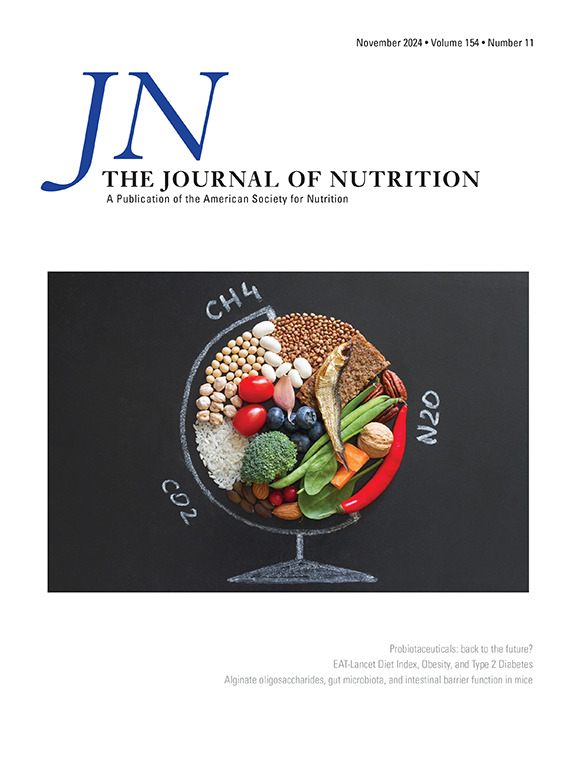Eggs, Dietary Choline, and Nonalcoholic Fatty Liver Disease in the Framingham Heart Study
IF 3.7
3区 医学
Q2 NUTRITION & DIETETICS
引用次数: 0
Abstract
Background
Eggs are rich in bioactive compounds, including choline and carotenoids that may benefit cardiometabolic outcomes. However, little is known about their relationship with nonalcoholic fatty liver disease (NAFLD).
Objectives
We investigated the association between intakes of eggs and selected egg-rich nutrients (choline, lutein, and zeaxanthin) and NAFLD risk and changes in liver fat over ∼6 y of follow-up in the Framingham Offspring and Third Generation cohorts.
Methods
On 2 separate occasions (2002–2005 and 2008–2011), liver fat was assessed using a computed tomography scan to estimate the average liver fat attenuation relative to a control phantom to create the liver phantom ratio (LPR). In 2008–2011, cases of incident NAFLD were identified as an LPR ≤0.33 in the absence of heavy alcohol use, after excluding prevalent NAFLD (LPR ≤0.33) in 2002–2005. Food frequency questionnaires were used to estimate egg intakes (classified as <1, 1, and ≥2 per week), dietary choline (adjusted for body weight using the residual method), and the combined intakes of lutein and zeaxanthin. Multivariable modified Poisson regression and general linear models were used to compute incident risk ratios (RR) of NAFLD and adjusted mean annualized liver fat change.
Results
NAFLD cumulative incidence was 19% among a total of 1414 participants. We observed no associations between egg intake or the combined intakes of lutein and zeaxanthin with an incident NAFLD risk or liver fat change. Other diet and cardiometabolic risk factors did not modify the association between egg intake and NAFLD risk. However, dietary choline intakes were inversely associated with NAFLD risk (RR for tertile 3 compared with tertile 1: 0.69, 95% CI: 0.51, 0.94).
Conclusions
Although egg intake was not directly associated with NAFLD risk, eggs are a major source of dietary choline, which was strongly inversely associated with NAFLD risk in this community-based cohort.
弗雷明汉心脏研究中的鸡蛋、膳食胆碱和非酒精性脂肪肝。
背景:鸡蛋含有丰富的生物活性化合物,包括胆碱和类胡萝卜素,可能有益于心脏代谢结果。然而,人们对鸡蛋与非酒精性脂肪肝(NAFLD)的关系知之甚少:我们调查了弗莱明翰后代队列和第三代队列在大约 6 年的随访中,鸡蛋和某些富含鸡蛋的营养素(胆碱、叶黄素和玉米黄质)的摄入量与非酒精性脂肪肝风险和肝脏脂肪变化之间的关系:在两个不同的场合(2002-2005年和2008-2011年),使用计算机断层扫描评估肝脏脂肪,以估计相对于对照模型的平均肝脏脂肪衰减,从而得出肝脏模型比率(LPR)。2008-2011年,在排除了2002-2005年流行的非酒精性脂肪肝病例(LPR≤0.33)后,在没有大量饮酒的情况下,将LPR≤0.33的病例确定为非酒精性脂肪肝病例。通过食物频率问卷调查来估算鸡蛋摄入量(分类为 结果:非酒精性脂肪肝的累积发病率为 0.5%,而酒精性脂肪肝的累积发病率为 0.5%:在总共 1414 名参与者中,非酒精性脂肪肝的累积发病率为 19%。我们没有观察到鸡蛋摄入量或叶黄素和玉米黄质的综合摄入量与非酒精性脂肪肝的发病风险或肝脏脂肪变化之间存在关联。其他饮食和心脏代谢风险因素也没有改变这种关联。然而,膳食胆碱摄入量与非酒精性脂肪肝风险成反比(三等分 3 与 1 的 RR 值:0.69,95% CI:0.51-0.94):虽然鸡蛋摄入量与非酒精性脂肪肝风险没有直接关系,但鸡蛋是膳食胆碱的主要来源,而在这一社区队列中,膳食胆碱与非酒精性脂肪肝风险密切相关。
本文章由计算机程序翻译,如有差异,请以英文原文为准。
求助全文
约1分钟内获得全文
求助全文
来源期刊

Journal of Nutrition
医学-营养学
CiteScore
7.60
自引率
4.80%
发文量
260
审稿时长
39 days
期刊介绍:
The Journal of Nutrition (JN/J Nutr) publishes peer-reviewed original research papers covering all aspects of experimental nutrition in humans and other animal species; special articles such as reviews and biographies of prominent nutrition scientists; and issues, opinions, and commentaries on controversial issues in nutrition. Supplements are frequently published to provide extended discussion of topics of special interest.
 求助内容:
求助内容: 应助结果提醒方式:
应助结果提醒方式:


